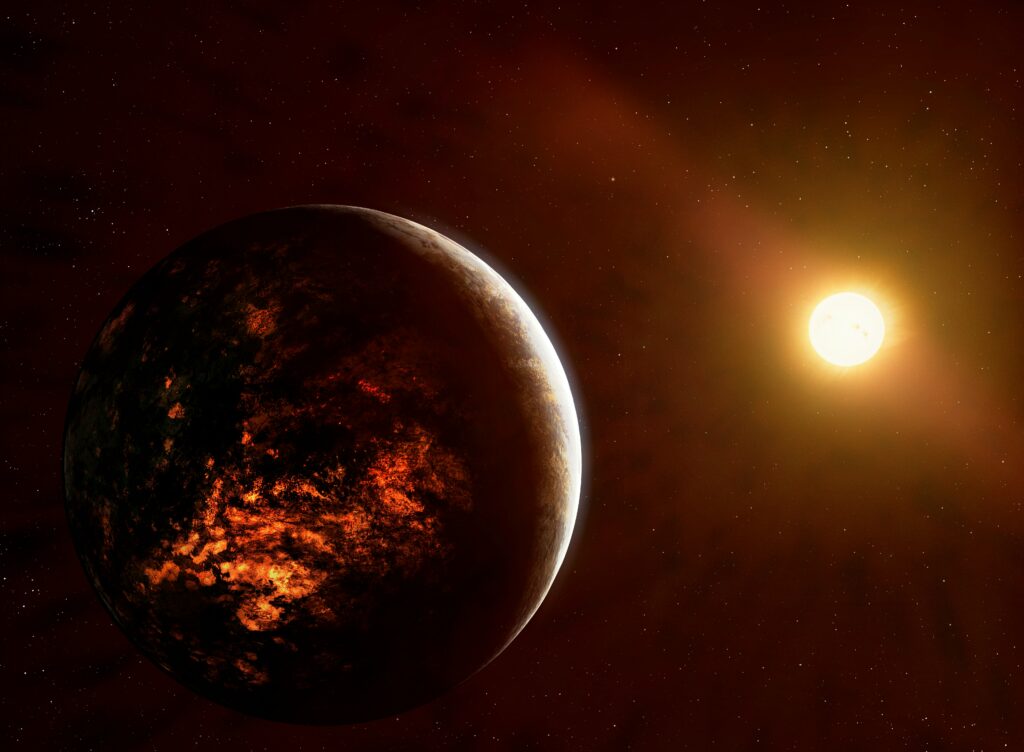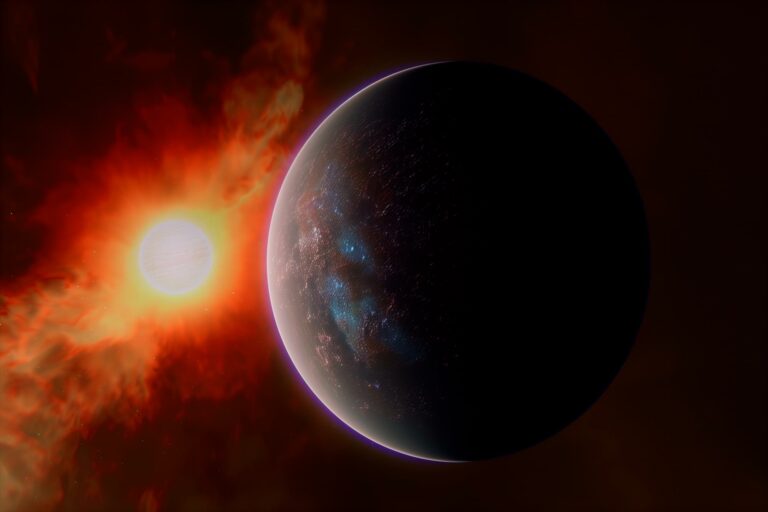The Webb Telescope has discovered a lava planet with a carbon dioxide atmosphere.
55 Cancri e is a terrible place, but at least its atmosphere isn’t actually vaporized rock.
Looking into the data from JWST, it is found that the lava world 55 Cancri e lacks the one of silicate ions vapor which we miss on our beloved home planet, Earth. Interestingly enough, another study suggests that this given planet is bigger than earth (with two times the diameter) and it revolves around its sun, which is at a distance of 40 light years. The atmosphere of the planet mostly consists of either carbon monoxide or carbon dioxide. This dense atmosphere is thought to exist due to the vapors, coming from the molten rock ocean overlying the planet’s internals.
Based on the fact, 55 Cancri e’s atmosphere is constituted mostly from carbon and oxygen elements; and the recent work on how such planet could be composed mostly of carbon diamond with dense core because of the extreme high temperature and pressure is not strange. Exoplanet researcher Renyu Hu, and his team from NASA’s Jet Propulsion Laboratory just published a research paper in the nature journal on the subject.

THE FLOOR IS LAVA – AND THE SKY IS POISON
While 55 Cancri e had its dark side facing that of its star, the other side at eternally hot temperatures of its sun finally turned the way toward Earth. JWST’s plan for that is to take help of Near-Infrared Camera (NIRCam) and Mid-Infrared Instrument (MIRI) to study spectral characteristics of light from the planet’s dayside. Indeed, that finding covered not only the exorbitant temperature ranges but also the chemical composition of the atmosphere as well.
The results from NIRCAM and MIRI confirmed the existence of a dense layer of either CO or CO2 around 55 Cancri e. The layer also contained many other molecules in the group of compounds such as hydrogen, nitrogen, oxygen, phosphorous, as well as sulfur, all of these molecules were carbon-based. The three such compounds were water vapor, sulfur compound, and molecular nitrogen (which gives volcanic gas such unfavorable aroma). The gas in this oppressive atmosphere overwhelmingly probably came from endless roiling bubbles beneath the planet’s incredibly hot lava surface.
Discovering that the planet’s atmosphere is about “a percent of its diameter” according to Hu and his team is not anything surprising since the planet whose diameter is 55 times that of Earth and twice that of Earth could have an atmosphere that is 80 to 800 miles thick. Right at this bottom locates the limitless world of the treigthonous magma.
As for astronomers, there is no land to be discovered around the 55 Cancri e and the planet is located at a miserably close distance to the star – only one and half times larger than our Sun, but keeps all the properties of a star. However, except for the nearest planet to the Sun in our Solar System, Mercury, that gives a distance of about 41 million miles, none of the other planets is nearer to the Sun than Earth. The star-approaching 55 Cancri e causes its altogether hot surface including the dark side, which is on the shady side, to approach ca. 2,500° F.
The fate of this exoplanet remained a mystery for astronomers until recently as they were not sure whether it harbored any kind of atmosphere or not, particularly a molten lava one. Such other research of the lava world zeroes in on the fact that we are up against the possibility that the atmosphere it was born with being thinner than what we are used to, perhaps composed of Hydrogen and Helium. However, here is a paradox with the temperature – it is lower than on Mercury but qualitatively higher than on Earth. Particular scientists have thought that the planet is so hot that it vaporizes rocks and so the atmosphere might be composed of them, miss JWST latest data.
“The findings disagree with the scenario, in which the planet is a lava world covered by the tenuous hazy atmosphere made of vaporised crust dioxide,” reads Hu and co-author team in their recent publication. Conversely, as opposed to the picture painted by our imaginations of 55 Cancri e as an ocean world, covered with clouds of water and other gases, this exoplanet seems rather to be a lava planet, smothered in gases burping out of its oozing lava.
Loki Patera was no the first lava lake because of the atomistic residues scientists observed on Io earlier due to the instruments in Galileo that reported alike phenomena. The photographs of the Juno mission are the most clear and complete respected to the Gotterdammerung photographs. In this computerized animation, NASA utilized the invaluable detail furnished by Juno to put the outline of overflying Loki Patera.
Loki Patera, a lava lake on Io, is believed to be formed when the ground above a magma reservoir sinks or collapses. This phenomenon is similar to calderas found on Earth, which occur when a volcano erupts and its top collapses inward due to a lack of magma support. However, Io’s paterae, or lava lakes, exhibit some differences that suggest they may have a unique formation process. A study conducted in 2001, utilizing data from the Galileo spacecraft, proposed that tectonic movements on Io may cause the crust to separate, resulting in gaps that collapse and form paterae.
Once a patera like Loki is formed, lava typically inundates its floor and often extends beyond its boundaries. This lava originates from underground magma chambers, which scientists believe are present beneath Loki Patera. In 2000, the Galileo spacecraft captured an image of a patera on Io, revealing magma surging in from fissures located at the base of its rocky walls.

Loki Patera is one of the lava lakes on Io, and it’s thought that it is the result of a portion of the surface sinking or collapsing above a magma reservoir underneath the ground. This process follows same principle as calderas which we have on the Earth. The caldera on the Earth occurs when a volcano erupts and its cap collapses due to a lack of magma. On this point, the lava lakes of Io are required to have an individual formation mechanism, the differences shown. Tectonic action was proposed in 2001 possibly causing tremors, these may split and break up the crust and eventually collapse to form paterae when the passages hang open due to the Io tidal springs
The patera of lava like Loki formed, lava as normal inundates its floor, otherwise it could go for some distance out side their boundaries, also. This lava might be generated from the flux of maternal magma chambers which are believed by scientists to exist under Loki Patera. In 2001 Galileo probe took the picture of a Patera making the prominence of the magma very evident as the magma surges towards the side of the rocky walls from an erruption at its base.
Do not forget to share your opinion with us to provide you with the best posts !




0 Comments